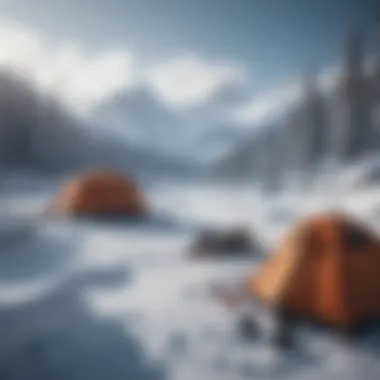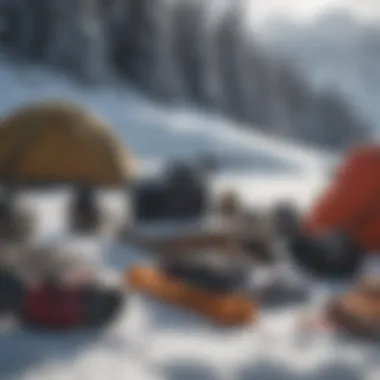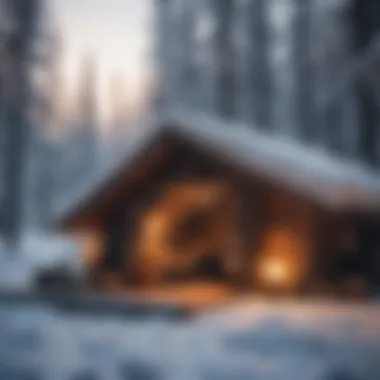Camping on Snow: Essential Tips for the Icy Wilderness


Intro
Camping in snow offers an experience unlike any other. The sheer solitude of white-draped landscapes draws the adventurous spirit, promising thrilling escapades under a blanket of frost. However, navigating this icy wilderness requires meticulous planning and the right gear. Whether you are a novice venturing into cold-weather camping or a seasoned athlete seeking the solitude of winter's embrace, preparation is key. The following sections will delve into essential gear, advanced techniques, safety measures, and the community aspect of snow camping, aiming to provide a comprehensive guide.
Equipment and Gear
When it comes to camping on snow, selecting the appropriate equipment is paramount. Here is a breakdown of essential gear that every winter camper should consider:
- Tent: Choose a four-season tent designed to withstand heavy snow and strong winds. Brands like Big Agnes and MSR offer models that provide excellent stability and warmth.
- Sleeping Bag: Insulation is crucial in frigid conditions. Look for down bags rated for extreme temperatures. The Marmot Lithium is a popular choice among campers.
- Sleeping Pad: An insulated sleeping pad acts as a barrier between the cold ground and your body. Options like the Therm-a-Rest NeoAir provide comfort and warmth.
- Clothing: Layering is essential. Invest in moisture-wicking base layers, insulating mid-layers, and waterproof outer layers. Brands such as Patagonia and North Face specialize in extreme weather gear.
- Cooking Gear: A compact, durable stove is necessary for winter camping. The Jetboil MiniMo is efficient and works well in cold temperatures.
- Navigation and Safety Equipment: A GPS device and a map of the area are crucial. Additionally, an avalanche beacon paired with a probe and shovel can be lifesaving in snowy terrains.
Maintaining this equipment is just as vital as choosing the right items. Regularly check for wear or damage, especially to tents and sleeping bags. New technologies and materials often emerge, so staying updated can improve your camping experience. Upgrading to lighter, more durable options can enhance your mobility and comfort.
Techniques and Training
Mastering techniques for winter camping can elevate your whole experience. Here, we discuss some key skills:
- Navigation: Knowing how to read a map and use a compass is essential. Practice these skills in a controlled environment before venturing into the wild.
- Setting Up Camp: Learn to pitch your tent quickly, especially in harsh weather. Techniques like creating a snow wall can provide additional protection.
- Building a Snow Shelter: Understanding how to construct an emergency snow shelter can be vital. Familiarize yourself with methods like the quinzee or igloo.
Exercises targeted at strength and endurance will further enhance your capabilities. Spend time climbing snowy hills or hiking in winter conditions to improve agility.
"Preparation can mean the difference between a thrilling adventure and a gripping survival scenario."
Safety and Risk Management
Safety cannot be overlooked when camping in snow. Here are some essential considerations:
- Understand Weather Conditions: Always check weather reports before your trip. Conditions can change rapidly in the mountains.
- Know the Terrain: Familiarize yourself with potential hazards, such as avalanche-prone areas or areas with unstable ice.
- First Aid Knowledge: Carry a well-stocked first aid kit and know how to use it. Familiarize yourself with hypothermia and frostbite symptoms as well.
- Emergency Plan: Communicate your plans with someone who will not be with you. Always carry a fully charged phone or a satellite communicator.
Using these strategies can minimize risks and improve decision-making in emergencies. Preparing for potential hazards and understanding how to react is essential for safety.
Events and Competitions
For those looking to test their skills against others, winter camping competitions and events are available across the globe. Engaging in these activities can enrich your camping experience and expose you to like-minded individuals. Notable events include:
- Various winter camping festivals.
- Snowshoe races.
Staying involved in this community through social media platforms like Reddit or Facebook can lead to opportunities to participate in these events.
Lifestyle and Community
Winter camping blends personal challenge with community spirit. Sharing experiences with fellow enthusiasts fosters camaraderie. Engaging with groups that emphasize winter adventures can enhance your overall quality of life. Furthermore, finding a balance between pursuing extreme sports and maintaining mental well-being is essential. Regular outdoor activities can rejuvenate the mind and body. Participate in local clubs or workshops that offer a support system during your winter outings.
This article has only touched upon the surface of what winter camping entails. With the right preparations, techniques, and community support, you can embark on an enriching journey into the snowy wilderness.
Prologue to Snow Camping
Camping on snow offers a distinctive opportunity to experience nature in its most tranquil and stark form. The challenges posed by winter conditions are significant, but they also lead to rewards that can be deeply fulfilling for adventurers. Understanding the art of snow camping not only enhances one’s ability to navigate through freezing temperatures but also primes individuals for survival in a harsh environment.
The Allure of Winter Landscapes
Winter landscapes have a unique charm that captivates many outdoor enthusiasts. The sight of glistening snowfields, frosted trees, and a still atmosphere is a visual treat. The quietude that settles in winter forests often invites reflection and peace that is hard to find in other seasons.
Moreover, these serene settings create an environment for solitude while also allowing for camaraderie among fellow adventurers. Engaging in snow camping also offers the chance to witness the wildlife that adapts to colder climates, presenting opportunities for observation that are both educational and exhilarating. Each winter scene tells a story, beckoning those with an adventurous spirit to immerse themselves in its beauty.
Understanding the Unique Challenges
Snow camping presents distinct challenges that differ from warm-weather camping. The temperatures can drop drastically, leading to potential health risks such as frostbite and hypothermia. Therefore, the need for specialized gear is essential. Tents must be appropriately designed to withstand severe weather conditions, and sleeping bags need to provide enough insulation for warmth.
Another consideration involves navigation. Snow can obscure familiar terrains, making reliable maps and GPS systems vital for a safe experience. An understanding of snow conditions is equally important, as both snow depth and stability can influence safety during a trip. Any seasoned snow camper will advise maintaining a cautious demeanor while prioritizing preparation.
"Preparation is key in snow camping. Without it, the allure of winter landscapes can quickly become a perilous adventure."
Recognizing how these challenges affect one’s experience is essential. Each aspect of snow camping, from gear to safety measures, requires careful thought and planning. This comprehension is crucial for ensuring not only enjoyment but also survival in such an unforgiving environment.
Essential Gear and Equipment
When venturing into snow camping, having the right gear is essential. Winter environments can be unforgiving. The appropriate equipment not only enhances comfort but is critical for safety. Adequate preparation with essential gear helps mitigate risks associated with cold weather.
Choosing the Right Tent


Four-season Tents
Four-season tents are designed to withstand extreme weather conditions. They are made with stronger materials compared to standard tents. This lends them a sturdiness that is vital during violent winter weather. The key characteristic of these tents is their ability to handle heavy winds and large amounts of snow. When snow camping, a four-season tent is beneficial because it offers the necessary protection against the harsh elements.
The unique feature of four-season tents is their low-profile design. This design minimizes wind resistance, which is crucial when setting up camp in exposed areas. Their disadvantage, however, is that they can be heavier and bulkier than three-season tents. It requires advance planning in terms of carrying them.
Warming Features
Warming features in tents can greatly enhance the snow camping experience. Insulation, double-walled constructions, or special reflective materials can keep the cold at bay. A key characteristic is the added warmth provided, ensuring safety and comfort during extreme cold. These warming features can be particularly effective in retaining heat generated from body warmth or portable heating systems.
However, it is important to note that tents with higher insulation may also trap moisture, if not properly ventilated. Therefore, while they are popular among campers, it is crucial to ensure adequate airflow to reduce condensation inside the tent.
Sleeping Systems for Cold Weather
Sleeping Bags and Liners
Sleeping bags adapted for cold weather are crucial for maintaining body heat during sleep. They often come with varying temperature ratings, ensuring comfort even in low temperatures. A key characteristic is their insulation material, which contributes to heat retention. Down insulation or synthetic fillings are popular in these bags due to their effectiveness in cold conditions. Their usefulness cannot be overstated for serious adventurers.
One unique feature of using sleeping liners is that they add an extra layer of warmth. This can be especially beneficial in temperatures that drop severely. The only disadvantage is the added weight when carrying them, which is something to keep in mind.
Sleeping Pads and Insulation
Sleeping pads create a barrier between the cold ground and the sleeper. They provide cushioning and insulation as well. The key aspect is that they significantly contribute to thermal insulation. Foam pads are a popular choice due to their reliability and lightweight nature.
One unique characteristic of sleeping pads is their ability to prevent heat loss to the ground. This can help maintain adequate body warmth. However, it is crucial to watch out for their puncture risk; air pads require care, as any damage can lead to losing insulation capabilities.
Cooking Gear for Snow Camping
Stoves and Fuel Choices
Selecting the right stove and fuel is imperative for cooking in snowy conditions. Winter conditions can make cooking outdoors tricky. A key characteristic of the ideal stove is its reliability in low temperatures. Liquid fuel stoves, for instance, operate better in cold conditions than canister stoves. They maintain burn efficiency despite chilly weather.
A distinct advantage of stoves that work with multiple fuel options is flexibility. However, this also can lead to complications if not carefully managed, as the availability of fuel types can vary.
Cooking Utensils
Appropriate cooking utensils are fundamental for convenience and efficiency. Lightweight and durable materials like titanium or aluminum are ideal for this environment. The key characteristic lies in the ability of these utensils to withstand harsh handling and temperature extremes.
Using multi-functional cookware can save space and weight, which is critical in snow camping. Their disadvantage, however, can appear in the form of higher costs associated with quality materials. In the context of snow camping, having the right cooking gear shapes the overall experience, enabling delicious and warm meals in an icy wilderness.
Strategy for Site Selection
Selecting a suitable campsite in snowy conditions is crucial for a successful snow camping adventure. The landscape can be unforgiving, and the wrong choice can lead to discomfort or danger. Understanding the strategy for site selection involves recognizing the characteristics of the snow-covered terrain and the specific requirements needed for safety and comfort. It is not only about finding a flat surface to pitch a tent but also includes various factors that can affect the overall experience.
Identifying Suitable Locations
Considerations for Safety
Safety stands out as a primary consideration when choosing a camping site in snow. One of the key aspects to watch for is the proximity to potential hazards, including cliffs, tree wells, and steep slopes. A flat area away from these features is ideal. This careful approach contributes to reducing risks and enhancing the enjoyment of the overall experience.
Being aware of the terrain can help prevent accidents that are prevalent in snowy environments. For example, a small error in judgment can lead to a serious fall or injury.
Another vital characteristic is the snow load on trees, which can break branches under pressure. Therefore, the consideration of tree branches overhead is crucial. This awareness makes this a beneficial choice for anyone venturing into the icy wilderness. In light of this, a site with fewer trees can provide better safety against falling branches or other dangers associated with snowy environments.
Avoiding Avalanches
Avalanche risks represent another essential consideration. Avalanches can be devastating and sudden; hence understanding how to avoid them is crucial. When selecting a site, always check the underlying snow stability. Areas with a history of frequent avalanches should be avoided at all costs.
The key characteristic here is recognizing the slope of the terrain. Steep slopes over 30 degrees are often too risky, as they are conducive to avalanche activity. A vital practice is to rely on avalanche forecasts for the area, which can significantly mitigate risks.
The unique feature of knowing how to avoid avalanches lies in assessing both the snowpack and the specific weather conditions that can exacerbate sliding. This knowledge enhances the camping experience by fostering a sense of security, allowing the individual to focus on exploration rather than concern for safety.
Understanding Snow Cover
The final element in site selection is understanding the layering of snow cover. Knowing its depth and condition is essential. For example, fresh, fluffy snow may be less stable than older, compact snow. This awareness can greatly affect both site stability and comfort.
After addressing these factors, selecting an ideal snow campsite becomes much more feasible. Safety and awareness lead to a rewarding experience, while understanding site characteristics can turn a strenuous task into a manageable one.
Safety Considerations in Snow Camping


When camping on snow, safety becomes paramount. The icy wilderness presents unique hazards that can quickly escalate if not properly managed. Understanding these risks and implementing suitable precautions ensures a safer and more enjoyable experience. Snow camping requires attention to potential dangers like hypothermia, frostbite, and the risks associated with traveling over ice. Equip yourself not only with gear but also with knowledge to navigate these cold conditions safely.
Potential Hazards and Risks
Frostbite and Hypothermia
Frostbite and hypothermia are among the most dangerous risks faced during snow camping. Frostbite occurs when skin and underlying tissues freeze, usually affecting fingers, toes, and the nose. Symptoms include numbness, tingling, and discoloration of the skin. Hypothermia, on the other hand, happens when the body loses heat faster than it can produce it. Symptoms may include shivering, confusion, and extreme fatigue.
Both conditions can escalate quickly, leading to serious injury or worse if immediate action is not taken. In this article, discussing frostbite and hypothermia will help to emphasize their prevention strategies, such as dressing in layers and maintaining body heat through activity. The awareness of these hazards contributes to a comprehensive approach to snow camping.
Traveling on Ice
Traveling on ice also poses significant challenges. Ice may appear solid, but it can be deceptive. It is critical to assess ice thickness and stability before venturing onto frozen surfaces. Falls can result in serious injuries or drowning in frigid waters beneath the ice. Evaluating conditions and using proper gear is crucial for safety.
By covering these aspects, readers can better understand the necessity of caution when traversing these surfaces. Knowledge of ice conditions, including cracks and sag, can greatly reduce accidents during snow camping outings.
Navigational Skills
Proper navigational skills are vital in snow camping. The unfamiliar landscapes can be disorienting, especially with features like blanketed snow. Knowing how to use maps and GPS effectively ensures that one can find safe pathways even under challenging weather conditions.
Using Maps and GPS
Using maps and GPS is essential for navigation. Traditional maps provide a detailed view of the terrain, while GPS systems offer real-time tracking. The combination allows for a thorough understanding of the surrounding area. Understanding how to interpret a map and calibrate a GPS unit can prevent lost routes and help maintain a clear course.
Navigational devices, however, are dependent on batteries that may die in cold weather. Carrying extras and learning how to navigate without electronic aids enhances safety.
Recognizing Weather Patterns
Recognizing weather patterns is another important skill. Weather in the mountains can change rapidly, and understanding these patterns can be lifesaving. Keen observation of the environment and atmospheric signs enables campers to anticipate changes, allowing for timely shelter setup or evacuation.
Monitoring forecasts before and during the trip can help prepare for any sudden shifts, thereby reducing the likelihood of hazardous situations.
Essential Skills for Snow Camping
When venturing into snowy terrains, acquiring essential skills is critical. It enhances safety and fuels confidence while navigating cold and challenging conditions. Effective snow camping requires understanding environmental elements and the ability to adapt. Skills can range from shelter building to fire management. Each skill contributes to managing the unforgiving cold and ensuring comfort during the outdoor experience.
Building Snow Shelters
Quinzees vs. Igloos
Different snow shelters serve various purposes. Quinzees and igloos are two distinct types of structures. A quinzhee is relatively quick to construct. You pile snow into a mound, let it settle, then hollow it out. This method is often easier than making an igloo. Igloos, by contrast, require snow blocks and a more intricate building process.
Key characteristics: Quinzees are more forgiving in terms of snow conditions. They allow for spontaneity in building, as building materials are less rigid. Igloos offer better insulation due to their solid walls and compact structure. They are effective against wind, thus providing better protection in extreme conditions.
Unique features: Quinzees can be built anywhere you find enough snow. However, their insulation can be less effective compared to igloos if not done right. The reverse can be true for igloos. While harder to make, igloos often provide unparalleled warmth.
Tools and Techniques
Tools and Techniques
Effective construction of snow shelters relies on proper tools and techniques. Essential tools include shovels, snow saws, and compacting tools. Snow saws allow for precise cutting of snow blocks in igloo making. A sturdy shovel is vital for pile management when building a quinzhee.
Key characteristics: Techniques vary from building the sturdy foundation of an igloo to the simple process of a quinzhee. The process of hollowing out space requires careful technique to retain wall strength in both cases.
Unique features: Each type of shelter demands its own approach. The quinzhee can often be built in less time, making it a good choice for beginners. Conversely, mastering igloo construction provides skills that are rewarding in more adverse conditions.
Fire Management
Creating heat in a snowy environment is vital for comfort and survival. Managing fire properly involves choosing the right wood, building an efficient structure, and ensuring safety practices. Mastery in fire techniques bolsters warmth in the freezing landscape.
Selecting Firewood
Choosing the appropriate firewood matters significantly. Not all wood burns well in low temperatures. Seasoned wood is the ideal choice. It burns more evenly and produces less smoke. Add to this the need to find wood that is dry and not buried under snow. Selecting your firewood wisely boosts the chances of a successful fire.
Key characteristics: Good wood burns more efficiently, creating less effort in maintaining fire. It also provides better heat output, crucial for cold nights.
Unique features: Dry wood is often scarce in snowy environments. A little planning before setting camp can ensure access to quality fuel. Using deadwood from trees within easy reach can also prevent unnecessary exertion.
Building an Effective Fire


Building a fire involves more than just lighting it. It requires understanding fuel types, wind conditions, and constructing a stable fire base. Starting with tinder, then gradually adding kindling before larger logs is the standard approach. Flame management through the use of stones can help keep the fire contained.
Key characteristics: An effective fire ensures warmth and a place for cooking or melting snow. Building a fire in snow requires adaptation to moment-to-moment conditions.
Unique features: Fires need regular attention in snowy conditions. The cold can snuff out flames quickly. Thus, understanding how to manage and rebuild your fire can mean the difference between comfort and misery in harsh cold.
Food and Hydration in Cold Conditions
Camping in snow poses unique challenges when it comes to food and hydration. The cold can reduce your appetite, but you must meet your nutritional and hydration needs to perform well and stay safe. Proper planning around food selection and hydration techniques can significantly impact your energy levels and overall experience.
Choosing Appropriate Foods
Caloric Needs
Caloric needs are crucial in the cold. In freezing temperatures, your body uses more energy to maintain its core temperature. Thus, only high-calorie foods can sustain your energy levels. Foods high in fats and carbohydrates are ideal as they provide a quick source of energy.
High-calorie meals, such as nuts, peanut butter, and freeze-dried meals, become essential. It's also smart to carry compact and lightweight options. This minimizes extra weight while ensuring the necessary energy supply. Keeping a close watch on caloric intake can help stave off fatigue and maintain body warmth, which is critical in extreme conditions.
Minimizing Spoilage
Minimizing spoilage is vital for ensuring food safety. In colder environments, food spoilage is often slowed, but it can still occur, mainly if food is improperly stored. Keeping perishables secure and using vacuum-sealed bags can greatly reduce risks. Foods high in preservatives are also beneficial because they resist spoilage better.
It's important to remember that moisture can lead to mold even in cold. Keeping food dry and airtight can help maintain quality. Additionally, planning meals that incorporate shelf-stable ingredients helps to reduce worries over spoilage, thus allowing a more enjoyable camping experience without food-related interruptions.
Water Sources and Treatment
Hydration is often overlooked in cold weather, but it remains equally important. The body can lose water through respiration, even in cold climates. Knowing where to find water and how to treat it is key.
Melting Snow
Melting snow provides an excellent water source. Although not always the most convenient, snow can serve as the primary hydration option during snow camping. To turn it into drinkable water, heat it over a stove. Doing so can ensure that it is safe, as it eliminates any potential pathogens found in snow.
However, note that consuming snow directly is not advisable, as it can lower body temperature. Always melt it before drinking. This method provides hydration without needing to carry significant water weight initially.
Water Filtration Techniques
Water filtration techniques enhance your ability to access clean water. Using portable water filters, like those from Katadyn or Sawyer, can effectively remove contaminants and pathogens from water sources. These filters are lightweight and easy to use, making them ideal for camping expeditions.
Understanding the types available is helpful. Some may remove bacteria and protozoa, while others may address viruses as well. Having a backup plan, such as chemical tablets or boiling, can also ensure access to safe water. Prioritizing water treatment can significantly improve your camping experience in the cold.
Proper food and hydration techniques not only fuel your body but also support your mental focus and overall enjoyment while navigating the icy wilderness.
Environmental Considerations and Leave No Trace
In the context of camping on snow, understanding environmental considerations and adhering to Leave No Trace principles is paramount. These concepts are not merely recommendations but essential practices for preserving fragile winter ecosystems. Winter habitats exhibit unique characteristics, and they are often more delicate than one might assume. Snow cover insulates the ground but can also mask the soil and vegetation beneath, making it crucial for campers to minimize disturbance.
Understanding Local Ecosystems
Local ecosystems in snowy regions are finely balanced. Flora and fauna have adapted to extreme conditions, with many species depending on specific seasonal cues. For instance, many animals rely on the snowpack as an insulating layer during winter months. Disrupting these habitats can have cascading effects on wildlife and plant life. To respect these ecosystems, it is important to stay on established trails and avoid trampling plants. Encouraging this practice not only safeguards these environments but also preserves the outdoor experience for future adventurers.
Sustainable Practices while Camping
Proper Waste Disposal
Proper waste disposal is essential in maintaining the integrity of snowy environments. When camping on snow, materials such as food waste, packaging, and human waste can contaminate pristine areas. One of the key characteristics of proper waste disposal is its emphasis on pack it in, pack it out. This practice ensures that campers take all waste back with them, preventing pollution.
The unique feature of proper waste disposal is the requirement to manage waste effectively in freezing conditions. Consider bringing biodegradable bags for human waste, which can safely store it until disposal is possible. The advantage of strict waste management is that it protects water sources and natural beauty. The disadvantages might include the additional burden of carrying out waste, but this is a necessary trade-off for preserving nature.
Minimizing Impact on Wildlife
Minimizing impact on wildlife is an important aspect of responsible camping. Wildlife in snowy regions often has limited food sources in winter. Disturbing their habitats can lead to stress and depletion of energy reserves. The key characteristic of minimizing impact on wildlife is to practice wildlife etiquette. This includes observing animals from a distance and avoiding feeding them.
By minimizing human interference, campers contribute to a healthy ecosystem. A unique element here is the potential for encounters with wildlife, which can be both thrilling and disruptive. Therefore, educating oneself about local species and their behaviors is essential to avoid negative interactions. The advantages of this approach include preserving the natural behaviors of wildlife and cumulative benefits to the ecosystem. It secures not just the experience for oneself, but also for other campers and wildlife alike.
Following Leave No Trace principles ensures that the splendor of nature remains intact for all future visitors.
Culmination and Final Thoughts
Camping on snow offers an unparalleled experience, but it demands careful consideration and preparation. This section underscores the importance of reflecting on one’s journey in the icy wilderness. When adventurers come together in the cold, they share not just the elements but also profound moments that define their experience.
The very essence of snow camping lies in understanding its dual nature. On one hand, there is the thrill of uncharted terrains, and on the other, the inherent risks tied to extreme conditions. Each camping trip is a chance to learn, whether through navigating challenges or appreciating the beauty of winter landscapes. This reflection can enhance the overall experience, transforming mere survival into heartfelt memories that linger long after the last snow has melted.
Another vital aspect revolves around encouraging responsible camping practices. As avid adventurers, enthusiasts of extreme sports have both the privilege and responsibility to protect the environments they explore. Following principles of Leave No Trace ensures these pristine spaces remain unspoiled for future generations. It is in the conscientious choices made by each camper that we see a true commitment to sustainability and respect for nature.
In summary, engaging in snow camping provides not just adrenaline-packed experiences but also valuable lessons in resilience, responsibility, and respect for the wilderness. By embracing these lessons, campers can ensure that their adventures contribute positively to the ecosystems they occupy, thereby fostering a culture that honors both adventure and environmental stewardship.















